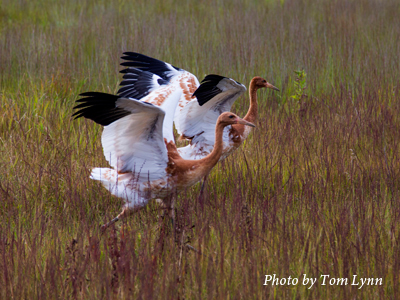Media Contact: Anne Sayers, Director of Marketing & Communications, 608-356-9462 x118, 608-658-0186 (cell)
 Waupun, WI – Eight captive-raised juvenile Whooping Cranes have been released to the wild from the Horicon National Wildlife Refuge near Waupun, Wisconsin. The endangered birds are expected to spend the next several weeks feeding and building their strength before following older cranes on their first migration to the southern United States.
Waupun, WI – Eight captive-raised juvenile Whooping Cranes have been released to the wild from the Horicon National Wildlife Refuge near Waupun, Wisconsin. The endangered birds are expected to spend the next several weeks feeding and building their strength before following older cranes on their first migration to the southern United States.
Since hatching this spring, the cranes have been raised at the International Crane Foundation by scientists mimicking adult Whooping Cranes. The handlers wear full-length crane costumes and use crane hand puppets to feed and interact with the chicks. This costume-rearing technique is used to make sure that the chicks are interested in other Whooping Cranes, and not people, a behavior that is critical to their survival in the wild.
“With great conditions and strong birds, we are very pleased with this year’s release. The chicks are familiar with the local crane roost sites from their previous explorations of the area, and they decided when to spent their first night outside of their enclosure, making this release much more gradual. The chicks have roosted with an older Whooping Crane in the area, and are also responding to the adult’s calls, so we have high hopes that they will stick together for the long trip south,” said Marianne Wellington, Senior Aviculturist and Chick-rearing Supervisor for the International Crane Foundation.
About 6-8 Whooping Crane chicks have been released each year since 2005 using similar methodology. The eight birds released this week will enter the Eastern migratory population, a population created by the Whooping Crane Eastern Partnership as a back up to the last remaining wild population that migrates between Canada and Texas.
The Whooping Crane is the tallest bird in North America, standing up to 5 feet tall. In the 1940s, there were fewer than 20 Whooping Cranes left in the wild. Their numbers have now climbed to about 400 in the wild. While today’s number is encouraging, it isn’t enough to guarantee the long-term survival of the Whooping Crane, especially given the number of threats they face, which include water shortages, power line collisions, habitat destruction, predation, and even shootings.
The chicks released this week will be carefully monitored and managed for the next few years as they explore habitats, pair with other cranes, and start their reproductive lives. The data on these birds will be added to existing data to help further understanding of Whooping Crane reintroduction.
The International Crane Foundation plays a leading role in the conservation of Whooping Cranes, from captive breeding and release programs, habitat protection, and threat reduction along their flyways. Learn more at www.savingcranes.org.
The International Crane Foundation works worldwide to conserve cranes and
the ecosystems, watersheds, and flyways on which they depend.
